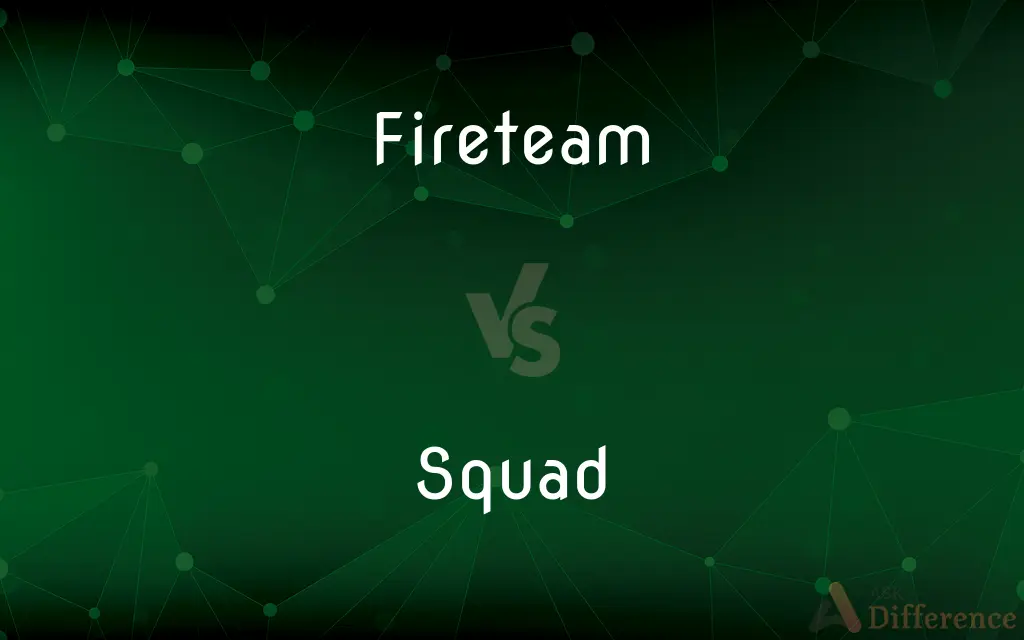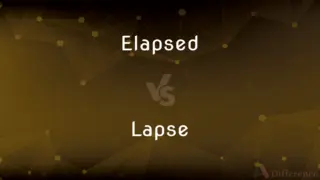Fireteam vs. Squad — What's the Difference?
By Tayyaba Rehman & Urooj Arif — Updated on April 9, 2024
A fireteam is a small military unit designed for flexibility and swift action, typically consisting of 4 soldiers. A squad is larger, usually made up of 8 to 14 soldiers, and comprises multiple fireteams.

Difference Between Fireteam and Squad
Table of Contents
ADVERTISEMENT
Key Differences
A fireteam is the smallest infantry unit in modern military tactics, usually consisting of four members, each with specific roles, such as rifleman, automatic rifleman, grenadier, and team leader. This structure allows for rapid mobility and effective engagement with enemy forces on a small scale. Squads, on the other hand, are larger units within the infantry, typically composed of two or more fireteams, with a designated squad leader in charge. The squad's size and structure enable it to undertake broader missions, providing a balanced mix of firepower, communication, and versatility.
The concept of a fireteam emphasizes close teamwork and adaptability, enabling the unit to perform a wide range of tasks from reconnaissance to direct combat. Fireteams are designed to be highly effective in urban and rugged terrains, where their small size allows for stealth and agility. Squads, with their increased manpower, are equipped to handle larger and more complex operations, including assaults on fortified positions, extended patrols, and securing larger areas.
Fireteams operate with a high degree of autonomy, making quick decisions in the heat of battle to respond to rapidly changing conditions. The intimate size of a fireteam fosters strong bonds among its members, enhancing their ability to communicate and coordinate effectively under stress. Squads, while still maintaining flexibility, operate under more structured commands, with squad leaders coordinating the actions of multiple fireteams to achieve strategic objectives.
In training, fireteam members are taught to maximize the effectiveness of their small unit through intensive practice in marksmanship, tactics, and communication. This training ensures that each member can perform multiple roles if necessary, increasing the team's resilience in combat. Squad training builds upon these individual skills, focusing on larger tactical maneuvers and the integration of fireteams into cohesive units capable of executing complex missions.
The integration of fireteams and squads within the infantry reflects a balance between the need for rapid, flexible response units and the requirements of larger-scale operations. This structure allows military forces to adapt to the challenges of modern warfare, where both small-scale engagements and larger tactical operations are essential for success.
ADVERTISEMENT
Comparison Chart
Size
4 soldiers, typically.
8 to 14 soldiers, usually.
Composition
1 leader, rifleman, automatic rifleman, grenadier.
2 or more fireteams with a squad leader.
Function
Close teamwork for swift action and flexibility.
Broader missions with balanced firepower and versatility.
Terrain Suitability
Effective in urban and rugged terrains for stealth and agility.
Equipped for larger operations and securing areas.
Autonomy
High degree of autonomy for rapid response.
Structured commands with coordinated fireteam actions.
Training Focus
Maximizing small unit effectiveness in combat.
Larger tactical maneuvers and cohesive unit operations.
Compare with Definitions
Fireteam
Specialized Roles:
Each member of the fireteam, from the rifleman to the grenadier, played a vital role in their mission's success.
Squad
Larger Military Unit.
The squad set up a perimeter defense, integrating the fireteams to cover all approaches.
Fireteam
Small Tactical Unit:
The fireteam moved quietly through the urban landscape, signaling to each other with hand gestures.
Squad
Strategic Operations.
The squad's operation to disrupt enemy communications involved precise coordination among its fireteams.
Fireteam
Specialized Roles.
Each member of the fireteam, from the rifleman to the grenadier, played a vital role in their mission's success.
Squad
Complex Missions.
Tasked with securing the village, the squad meticulously planned their approach to minimize civilian disruptions.
Fireteam
Autonomous Operations:
Cut off from their squad, the fireteam made split-second decisions to ensure their survival and mission success.
Squad
Versatile Engagement.
Whether patrolling or engaging in direct combat, the squad's diverse capabilities allowed it to adapt to various threats.
Fireteam
Small Tactical Unit.
The fireteam moved quietly through the urban landscape, signaling to each other with hand gestures.
Squad
Coordinated Fireteams.
The squad leader directed the fireteams to flank the enemy position, maximizing their firepower.
Fireteam
Rapid Mobility:
The fireteam quickly navigated the rugged terrain, staying undetected by enemy forces.
Squad
In military terminology, a squad is amongst the smallest of military organizations and is led by a non-commissioned officer. NATO and US doctrine define a squad as an organization "larger than a team, but smaller than a section." while US Army doctrine further defines a squad as a "small military unit typically containing two or more fire teams." In US usage, a squad consists of eight to fourteen soldiers, and may be further subdivided into fireteams.
Fireteam
Squad
Squad
A small group of people organized in a common endeavor or activity.
Fireteam
Rapid Mobility.
The fireteam quickly navigated the rugged terrain, staying undetected by enemy forces.
Squad
The smallest tactical unit of military personnel.
Fireteam
Close Combat Teamwork:
In close quarters combat, the fireteam's coordination was crucial to clearing the building.
Squad
A small unit of police officers.
Fireteam
Close Combat Teamwork.
In close quarters combat, the fireteam's coordination was crucial to clearing the building.
Squad
(Sports) An athletic team.
Fireteam
Autonomous Operations.
Cut off from their squad, the fireteam made split-second decisions to ensure their survival and mission success.
Squad
A group of people organized for some common purpose, usually of about ten members.
Fireteam
A fireteam or fire team is a small military sub-subunit of infantry designed to optimise "bounding overwatch" and "fire and movement" tactical doctrine in combat. Depending on mission requirements, a typical fireteam consists of four or fewer members: an automatic rifleman, a grenadier, a rifleman, and a designated team leader.
Squad
A unit of tactical military personnel, or of police officers, usually of about ten members.
Fireteam
A small unit of infantry.
Squad
A group of potential players from whom a starting team and substitutes are chosen.
Squad
(informal) A collective noun for a group of squid.
Squad
(slang) One's friend group, taken collectively; one's peeps.
Squad
Sloppy mud.
Squad
(intransitive) To act as part of, or on behalf of, a squad.
We squad on the fifth of the month.
Squad
A small party of men assembled for drill, inspection, or other purposes.
Squad
Hence, any small party.
Squad
Sloppy mud.
Squad
A smallest army unit
Squad
A cooperative unit
Common Curiosities
How does a squad differ from a fireteam in military operations?
A squad is larger and capable of undertaking more complex missions by coordinating multiple fireteams.
How does the size of a unit affect its combat role?
Smaller units like fireteams are suited for swift, flexible responses, while larger units like squads handle complex operations.
Can a fireteam operate independently?
Yes, fireteams are designed for autonomous operations, making quick decisions in combat.
How are squads and fireteams integrated within the infantry?
Squads comprise multiple fireteams, offering a mix of rapid action capabilities and broader mission execution.
What kind of training do fireteam members receive?
They receive intensive training in marksmanship, tactics, and communication for versatility and effectiveness.
What are the responsibilities of a squad leader?
To coordinate the actions of the fireteams, ensuring the squad operates as a cohesive unit toward strategic objectives.
What is the primary purpose of a fireteam?
To provide flexibility and rapid response in combat situations through close teamwork.
What roles are found within a fireteam?
Common roles include a team leader, rifleman, automatic rifleman, and grenadier.
Why are strong bonds important in a fireteam?
Strong bonds enhance communication and coordination under stress, crucial for combat effectiveness.
Can squad members perform roles outside their specific designation?
Yes, training ensures members can adapt to various roles, enhancing the unit's resilience.
What is the advantage of having multiple fireteams within a squad?
It provides a balance of firepower, communication, and versatility, essential for larger operations.
What terrain is a fireteam particularly effective in?
Fireteams excel in urban and rugged terrains, where their agility and stealth can be maximized.
Share Your Discovery

Previous Comparison
Elapsed vs. Lapse
Next Comparison
Disproportional vs. DisproportionatelyAuthor Spotlight
Written by
Tayyaba RehmanTayyaba Rehman is a distinguished writer, currently serving as a primary contributor to askdifference.com. As a researcher in semantics and etymology, Tayyaba's passion for the complexity of languages and their distinctions has found a perfect home on the platform. Tayyaba delves into the intricacies of language, distinguishing between commonly confused words and phrases, thereby providing clarity for readers worldwide.
Co-written by
Urooj ArifUrooj is a skilled content writer at Ask Difference, known for her exceptional ability to simplify complex topics into engaging and informative content. With a passion for research and a flair for clear, concise writing, she consistently delivers articles that resonate with our diverse audience.














































